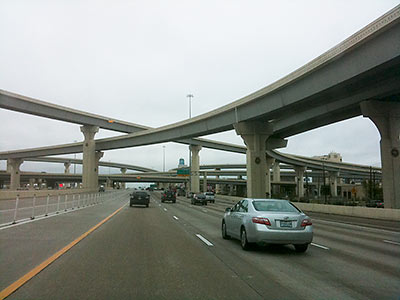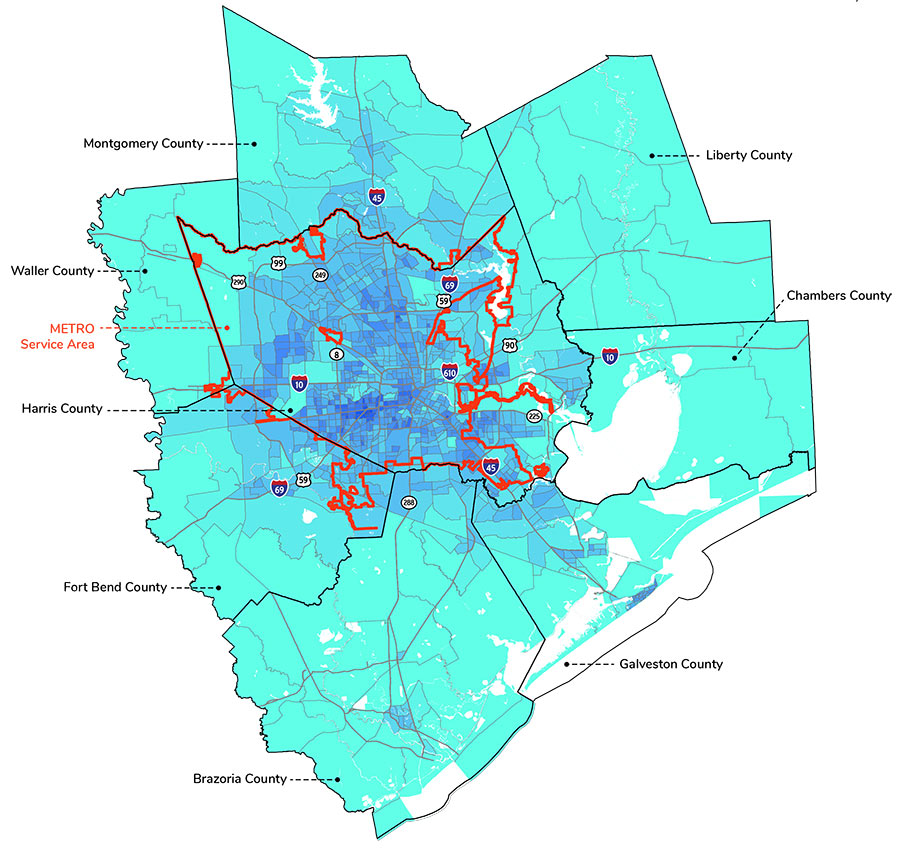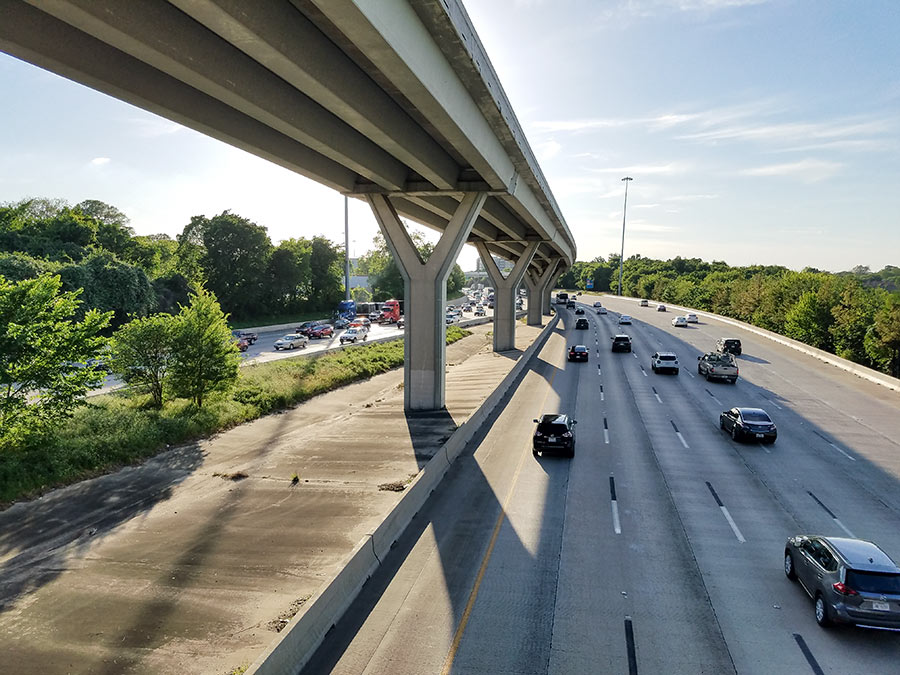WHICH CAME FIRST: THE TRAFFIC OR THE FREEWAY LANES?  “Population growth doesn’t happen independently of transportation infrastructure—it’s profoundly shaped by it,” writes Daniel Hertz over at City Observatory this week. Hertz’s commentary comes in response to pushback following an article in which the blog weighed the outcome of the Katy Freeway’s 2008 expansion (calling out 30- and 55-percent increases in morning and afternoon commute times between 2011 and 2014). Pro-expansion readers purportedly commented that while travel times along the corridor did actually get worse, those same slowdowns would have been even stickier had the expansion not taken place when it did. But that’s backwards, argues Hertz, or at least a simplification: “In fact, research dating back at least to the 1950s has found over and over that highway construction in the urban periphery is associated with more housing construction there—and the depopulation o[f] urban neighborhoods. . . . Part of the way that highways fill themselves up with cars is by creating demand for housing near them.” [City Observatory, previously on Swamplot] Photo of I-10 West: Andres Lombana [license]
“Population growth doesn’t happen independently of transportation infrastructure—it’s profoundly shaped by it,” writes Daniel Hertz over at City Observatory this week. Hertz’s commentary comes in response to pushback following an article in which the blog weighed the outcome of the Katy Freeway’s 2008 expansion (calling out 30- and 55-percent increases in morning and afternoon commute times between 2011 and 2014). Pro-expansion readers purportedly commented that while travel times along the corridor did actually get worse, those same slowdowns would have been even stickier had the expansion not taken place when it did. But that’s backwards, argues Hertz, or at least a simplification: “In fact, research dating back at least to the 1950s has found over and over that highway construction in the urban periphery is associated with more housing construction there—and the depopulation o[f] urban neighborhoods. . . . Part of the way that highways fill themselves up with cars is by creating demand for housing near them.” [City Observatory, previously on Swamplot] Photo of I-10 West: Andres Lombana [license]





perhaps somewhat relevant, but at the end of the day nobody should care. the primary discussion should be the impact of a cities transportation infrastructure on it’s GDP growth & standards of living. how would highway funding better impact Houston’s GDP growth if funneled elsewhere? that’s the only question people should be discussing.
.
city growth patterns are determined by the cost of transportation (both time & monetary) and a lot of variable factors play into that (some within a cities control, others not). it’s not just about cars & highways.
Any expansion to any mode of transport is going to induce demand. If we had a rail-dominated transport system, you’d see the same thing if a new commuter line was built out to Katy – only the trains would be full of new Katy residents instead of massive highways full of cars.
.
The real crux of the issue here is that Americans are constantly sold on the idea that cars represent ultimate freedom and prosperity. That image breaks down when crowds of commuters start forming giant, slow-moving, panic-inducing trains of automobiles. The cognitive dissonance causes automobilists to latch on to the only solution they can imagine: wider roads will restore that feeling of freedom. Of course, it never really works out that way.
cars are not an idea that was *sold* to anybody, they are a natural consequence of technological development and human drive. they also happen to be cheap, flexible and accessible, which makes them a far superior method for the expression of personal preferences — which is exactly what suburbs are — than extremely high cost, inflexible and exponentially-decaying-with-distance accessibility of trains. I don’t understand this fetish people have with trains for moving people. It’s probably the worst way to get humans anywhere, and is better suited for cargo. Incidentally, the US has the single best rail system in the world. It’s just used for cargo instead of people, so nobody likes it.
Most discussions of this sort gloss over the fact that transit-oriented development requires high population density to work well/economically. AKA, all but the very wealthy live in mid- and high-rise shoeboxes. No thanks, I’m glad that Houston’s development pattern has enabled the middle-class to enjoy high-quality single-family housing stock.
No, you can’t build enough lanes to satisfy all current and future commuter traffic demands, but there are other solutions, market-driven and technology-driven. Companies relocate offices to the suburbs to shorten their employee’s commutes (and often take advantage of lower rent rates/land prices). P+R buses provide front-door service to downtown office buildings. Self-driving cars will make long-distance commuting more palatable and will increase freeway capacity dramatically by driving very close to one another. Etc.
The love affair with trains by a certain group of urbanists in the US is a Grass is Greener on the other side mentality, they always point how wonderful public transport is in Europe. Well, if you actually lived in you Europe, and I have for many years, you realize that public transport is a horrible pain in the ass to live with every day. It’s inefficient if you have to go anywhere that is not on direct route, you have to make plans days in advance if you need to be across town at a particular time, you have to go to the market every F-ing day to buy food because you can’t carry more than a couple of bags at a time. You eventually give up after a while and end up confining your life to within a couple of blocks of your house. Don’t even get me started when the weather is bad. There’s one thing everyone in dense European cities dreams of …. Owning a Car.
The real story behind the Katy Freeway transit times is that they did a crappy job designing the freeway expansion. It always jams up at 8 and I-10 because they put the exit and on ramps too close together. People exiting have to slam on the breaks to try to wedge themselves into the traffic coming on to the highway. The flyovers for 8 should have been wider too. They back up into I-10 during rush hour. Then there are the stupid HOV lanes. They should have built a hard barrier between the HOV lanes and regular lanes so they could be closer together. That would have allowed for at least an additional lane in the regular lanes which would make a big difference in the choke points at Beltway 8 and 610 where I-10 goes from 5 lanes to 4. I would reduce the HOV lanes to a single lane so I-10 would have 5-6 lanes instead of 4-5. While I am certainly one to rail against suburban expansion, the real story may be that there is a saturation point where highway expansion designs just create as many problems as they solve. A sort of “too big to succeed” problem.
The inherent convenience, comfort and privacy of automobiles will make them the first choice of transportation for most folks. Unfortunately, congestion is an unvoidable outcome in the automobile system, at least in a thriving economy; decentralization of jobs has sort of just moved congestion around, not made it go away. Anyone who thinks that the highway expansions will somehow make congestion disappear on more than a short term basis, at least in a growing area of the region, is fooling themselves. That doesn’t mean the expansions are bad; after all, you’re still moving more people, even if it is at 10 mph.
Where the free market has chosen to create density of jobs, homes, or other activity (and our activity centers and urban core densification prove that this is a real market force), then it makes sense to examine other options for mobility. Our P&R system is a great example of an effective alternative, and one that should be expanded to serve more areas. Improvements to the basic bus system are vital – we got started on that last year but more would help. Making denser areas amenable to walking and biking is critical (why make people get in cars for short trips if they don’t feel they have to – you’re just adding needless congestion). Rail might make sense for certain types of really high volume travel corridors, but it’s horrifically expensive so the bar for justification is really really high, and I think METRO’s latest lines probably don’t meet that criteria.
Cars don’t offer freedom. Nothing is free; not even walking. Cars do offer flexibility and relative comfort. They make it so that if you get laid off and then find a job across town, that you can accept the job and get there without having to give up your lease or sell your house. They make it so that a married couple can have two jobs, completely across town from one another or with one even outside metro area, and that they can order their lives in such a way as to split the difference. They make it so that you can take shelter from inclement weather, maintain a comfortable temperature, and enjoy audio stimulation or even phone calls (hands-free, of course) however you please without disturbing others.
Say what you will about the slippery slope of development patterns that had their origins in the 50’s (or earlier), and about what might’ve been. The reality is that those patterns exist. They have spawned multi-centric cities with job clusters that cannot be served by any traditional forms of public transit, especially along fixed guideways. Those development patterns are well established, they are a legacy issue, and no policies short of a Napoleanic total reconstruction of a city will be at all effective.
About that, however, I am also hopeful regarding a future of autonomous driver-less ridesharing/carpool services. If that comes to pass, as appears increasingly likely(!), then it is quite easy to imagine that cities with legacy infrastructure could de-congest and actually become quite efficient and less expensive to get around in, resolve parking requirements as a cost factor that constrains urban growth, and also continue to enjoy the factors that make housing relatively affordable. That scenario probably doesn’t bode well for Houston quite so much, however, as approximately half of global oil consumption is linked to household transportation and, with or without electric cars, this scenario would entail some significant demand destruction.
@TheNiche, you bring up a very good point about imminence of ride sharing and automated cars. It could be a perfect solution, it would maintain full flexibility of a car and car pool ability during peak hours, all while using existing infrastructure. It would eliminate a lot of problems that hamper car pooling today, one being “I’m not letting those filthy bastards ride in MY car” (it won’t be your car)… If I have to run somewhere else after work and not directly homes, I can simply summon a different car and let the rest of the car pool go home… It would be door to door service and not sweaty walk to a bum filled bus stop service….eliminates parking, the car would go find parking somewhere cheap… etc, etc, etc.
Hertz is correct and his detractors are blathering imbeciles (ok ok getting too caught up in Trump style arguments). He is spot on correct, though. Imbecile planners (sorry, can’t help being like trump when he’s so effective) need to stop wasting money on freeways 30, 40 and 50 miles out from the city center and start putting infrastructure in neighborhoods closer in. There is one proven, sure-fire way to eliminate a commute – live closer in. But, moron planners won’t stop building freeways as far west as west goes. Soon, we will be commuting in from San Antonio if these pathetic losers keep getting what they want.
Most of these comments in favor of expansion are about the convenience of automobiles, but ignore the cost. Most people with a basic grasp of economics understood that the expansion would only work for so long before continued sprawl filled it up. A major lobbying force behind the road expansion push is always the suburban developers, who recognize that they need ever-increasing road capacity to make their speculative investments in distant prairie land become profitable.
.
But there comes a point where the cost of expansion is simply too great. We’ve probably reached that point with I-10. We can’t make it any wider, it’s already the widest freeway in the world. We wiped out a massive chunk of tax base for some of the smaller towns along the route. Some of it came back, but that would disappear in another expansion. Our options are to go up (do the dual-layer freeway many proposed the last time), or go mass-transit.
.
We have a unique opportunity in the region, with our multi-center layout. We could have arterial commuter rail between major centers (e.g. CityCentre/Memorial, The Woodlands, Sugarland, etc.) and downtown, with local bus and light rail connections radiating from there. Of course, people will still have to get off their fat backsides and walk a little farther than a parking lot distance, and that will require some serious walkability improvements. Not to mention a sea change in a culture where it’s preferable to drive around a parking lot for 10 minutes to find a spot closer to the door, than have to walk an extra 50 feet.
@derek, Wired did a piece on this very thing, “induced demand.” Read it here”
http://www.wired.com/2014/06/wuwt-traffic-induced-demand/
would the energy corridor have expanded if i10 weren’t expanded? would places intersected by hwy99 be exploding if there were no 99?
.
the simple answer is no, the energy corridor wouldn’t have expanded as quickly as it did, and places along 99 wouldn’t be exploding in size.
A common theme here seems to be that Houston’s sprawl resulted from the noble choices of consumers in a free market. However, there are so many market conditions we take for granted that were driven by top-down decisions. For example, the fact that you can buy a SF detached home in the suburbs depends on the Federal government explicitly backing 30 year mortgages and governments picking up the tab for suburban infrastructure. The parking regulations and road design methodologies that dictate city layout and enable high-speed automobile traffic are conceived by a few government traffic engineers. We are far from living in a “free market” driven city.
Another common misconception is that cars provide flexibility and comfort. This is only true if you live in a city designed for cars. Imagine if there was actually some pocket of Houston that was actually livable without a car. In such a place, 80% of your needs, like groceries, hardware, parks, schools, etc. would be within a 5-20min walk or transit ride. Via transit, you likely won’t be spending that much more time in the weather than if you were to walk from your car across a parking lot. Aas automobilists, we wear indoor clothing most of the time. Living in a walkable neighborhood simply means an adjustment to using umbrellas/rain gear or more heat-appropriate clothing.
We don’t need to redo Houston like Napoleon did Paris, but we can start legalizing development of car-free neighborhoods for those who want them. We can also start incentivizing these sorts of developments for people of all incomes if we really want to seriously tackle traffic fatalities, climate change, and energy independence.
@Derek: Car-free neighborhoods are already legal to build, and if fact, do exist. They just don’t exist in Houston because that isn’t what Houston is for. Houston’s purpose is to be a sort of experiment. It was invented by less than truthful real estate developers to see what would happen if less than truthful real estate developers were allowed to run a city. This should be obvious to anyone with the slightest knowledge of Houston’s history, so we can assume that the people who choose to live here are willing participants in the experiment. So go, live in a car-free neighborhood. It’s a blast! But do it someplace else. Leave us here to continue our experiment.
I’ll say this. Does Houston have MAJOR infrastructure and transportation issues, specifically around vehicular traffic? YES.
But, if someone wants to buy some slapped together cookie-cutter house in a copy-cat subdivision in Katy and doesn’t mind spending 3 or 4 hours a day in a car getting to and from work to get it? More power to them. I’d rather jab myself in the eyes with a fork.
Conversely, I don’t want to live like a rat in a shoebox townhouse. Traffic inside 610 along Washington, Shepard, Kirby, Montrose, Westheimer…that’s all just as dreadful as I10 is…because of all the new townhouses, condos, and apartment complexes built on these ragged streets.
That’s why I bought a house in Glenbrook Valley. It’s 10 minutes to downtown. I get a nice sized house with a nice sized yard at a cheap price not far from town. I work near IAH, so I take 610 East North and 59 North every day…59 North in the morning is Gods highway…I never sit in traffic! It’s 30 miles but it’s 30 minutes.
Point being, Houston has traffic issues and needs a better plan, but if people are willing to deal with the awful traffic to live where they do…who cares? They should move.
@ Memebag: No question Houston is an exciting and often wonderful experiment. Part of that experiment should be that if developers want to start building as if there’s a market segment that wants a car-free life, which there more than likely is (otherwise the developers wouldn’t spend the money to build such a place), then they should be allowed to do so. And the public sector would benefit from having a basic set of infrastructure and policies allowing this to happen (that doesn’t necessarily mean super-expensive public transit). If you’re implying that such development “doesn’t fit the experiment”, then you’re the one who doesn’t understand what the experiment is.
@ commonsense: Well, the modeling that I’ve looked at tends to indicate that the most efficient setup in a suburb-to-activity-center flow would probably be where a rideshare/carpool circulates in a neighborhood and gathers a few people and then delivers them to a high-capacity high-frequency transit trunkline. The individuals go as far as any of them need to, get off, and then use a shuttle operating on the same concept to circulate around to each person’s final destination. That would be the lowest-cost option, anyway, and for a lot of people that’d be awesome and a lot faster than any other currently-existing options. But hey, there are enough people that there’s no reason that you couldn’t have the same concept for single-passengers, luxury vehicles, even limo services or light hauling. Its just that the price of the service would reflect it. Naturally.
.
@ Chris C: You said, “Most people with a basic grasp of economics understood that the expansion would only work for so long before continued sprawl filled it up.” About that, I have to agree. But also, the fact that its being used is an indicator that the improvement was valued by the public. It could also indicate that the project was too small or poor design or poor integration with other elements of the transportation system. The especially heavy reverse commuting, too, indicates that it is serving a very broad population. And about all that,at least, its kind of hard to knock the I-10 project.
Maybe the opportunistic developers need to pay to support the infrastructure stressed by the excessive building. There’s a thought. Instead, they build and leave.
@Mary, if it’s done that way then the property taxes need to be drastically reduced and the prices of the homes must be jacked up. See, simplistic reactionary ideas fall apart quickly.
I wonder where Hertz thinks all those people who bought out in Katy would live if there were no houses for them to buy out there? It’s not like developers can easily go and buy an existing 150 acre plot of land inside the Loop for a new subdivision. And, I doubt many of those folks would be the least bit interested in living in a mid or highrise building. Face it, people like living in a house with a yard and room for the stuff that they use in their life.
@Ross: I did move (far away) and it was one of the best decisions that I have ever made. I worry about the people that don’t have the opportunity or means to move away due to various structural and historical occurrences within out society at large.